 Image search results - "rope" Image search results - "rope" |
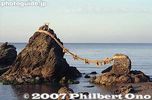
Meoto-Iwa Wedded Rocks off the coast of Futami-cho, Ise city, Mie Prefecture. 夫婦岩
|
|

The Wedded Rocks are part of Futami Okitama Shrine known for frog sculptures. 二見興玉神社
|
|
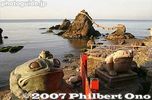
The shrine is dedicated to Sarutahiko and Ukano-mitama. Sarutahiko is a god which serves as a pathfinder guide. Deities for land/sea transportation safety. 二見�
|
|

The frog is Sarutahiko's messenger. Frog is called "kaeru" in Japanese, which is a homonym for the another word meaning "return home." If you travel a lot, pray here for a safe return. 夫婦岩
|
|
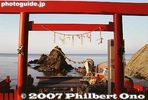
Futami Okitama Shrine does not have a main hall (Honden) like most other shrines. It worships the Okitama Sacred Stone in the ocean beyond the Wedded Rocks. 二見興玉神社
|
|
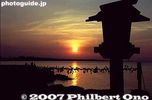
Lantern and sunset at Futami Okitama Shrine
|
|

Sunset at Futami Okitama Shrine. In the old days when traveling was a hazardous undertaking in Japan, pilgrims who traveled to worship at the Ise Grand Shrines prayed here for a safe return home.
|
|
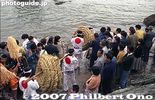
Men carry spanking-new shimenawa ropes to the rocks.
|
|
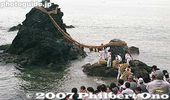
The Wedded Rocks are actually a type of torii gate for worshipping the Okitama Sacred Stone in the ocean.
|
|

The torii on the larger rock is quite small. The sacred rope is replaced three times a year on May 5, September 5, and at the end of December.
|
|
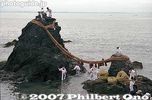
5月5日、9月5日と12月下旬には夫婦岩の大注連縄の張り替え神事が行われる。これらの写真は5月5日に撮影された。
|
|

In front of Tokorozawa Aviation Museum is a Curtiss-Wright C-46 transport plane.
|
|
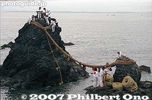
The men begin to cut off the old rope. Those sharp sickles soon made short work of the old sacred ropes which were brought ashore in small pieces.
|
|

The C-46 was used by the Japan Air Self-Defense Forces for cargo transport from the 1950s.
|
|
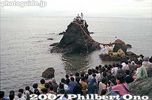
The ceremony attracts a large crowd.
|
|

Monument for Japan's Birth of Aviation 日本の航空発祥の地・所沢
|
|

The shimenawa rope actually consists of five smaller ropes. They cut the ropes one by one.
|
|

The ropes are now completely cut, breaking the bond between the two rocks.
|
|
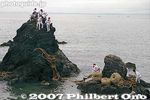
The old rope is taken away.
|
|
|
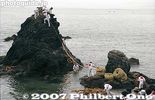
The new ropes are strung across the two rocks. A small rope tied to the end of the large rope is used to pull the large rope up the rock.
|
|
|

The first rope is wound around both rocks.
|
|

The second rope is installed.
|
|
|
|

One by one, the men carefully positioned the new sacred ropes on the two Rocks. All the while, young children and young men are chanting on the shore.
|
|
|
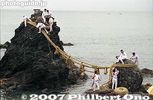
Replacing the rope for the Wedded Rocks, Mie Pref.
|
|

Five ropes are being positioned and made taut.
|
|
|

All the while, the cheering section chants and wave streamers.
|
|
|
|
|
|

Pieces of the old rope. Anyone could take home the pieces of old sacred rope if they wanted.
|
|

Making sure that the rope is aligned and positioned correctly.
|
|
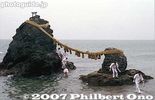
The job is finished.
|
|

The rope installers return to shore.
|
|
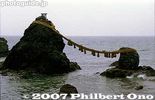
Wedded Rocks with a new rope. Japan has numerous other Wedded Rocks and stones, but this is by far the most famous.
|
|

Sacred rock where the god lives.
|
|

The famous Clock Tower or Tokeidai is overshadowed by much bigger and modern buildings in central Sapporo. A short walk from Sapporo Station and Odori Park.
|
|

The Clock Tower was built in 1878 as part of the Sapporo Agricultural College established largely by three Americans from Massachusetts: Dr. Willian S. Clark, William Wheeler, and David P. Penhallow.
|
|

The Clock Tower was used as a drill hall and ceremony hall. After the college moved, the building was used by local citizens for cultural purposes such as a library and lecture hall.
|
|

The construction of the tower and installation of the clock was completed in 1881. The clock was made by Howard Clock Co. of Boston, MA. It is still in the Clock Tower, sounding its original chime.
|
|

Front entrance of the Clock Tower.
|
|

The Sapporo Clock Tower is an Important Cultural Property.
|
|

The clock inside the tower is Japan's oldest. The gears and other main parts are also still the original ones. Thanks to excellent care and maintenance, the clock has come this far.
|
|
|
|
|

Inside the Sapporo Clock Tower. The first floor has various display panels and exhibits.
|
|

The exhibits explain about the history of Hokkaido's early settlement and development.
|
|

Scale model of what the Sapporo Agricultural College looked like. Notice the Clock Tower. In those days, Sapporo's population was only 2,600.
|
|

Records of songs which mention the Clock Tower.
|
|
|

Panel showing foreign instructors who taught at Sapporo Agricultural College.
|
|

Second floor of the Clock Tower. Mostly pews for a lecture hall.
|
|

A working clock
|
|

On New Year's Eve, a crowd gathers to hear the Clock Tower ring in the New Year.
|
|
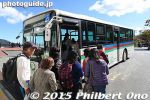
When I visited in Nov. 2015, the ropeway was still closed between Sounzan and Owakudani. So at Sounzan, we boarded a bus for Ubako.
|
|

This is Owakudani, now a danger zone and off limits. These photos were taken from an earlier trip. Hakone is part of the Fuji-Hakone-Izu National Park.
|
|
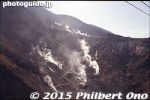
The ropeway goes right over a dramatic and steaming valley.
|
|
|
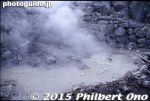
You can get off at Owakudani and see some steamy puddles.
|
|
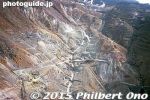
Owakudani
|
|

Mt. Fuji
|
|
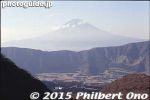
Mt. Fuji from Hakone.
|
|
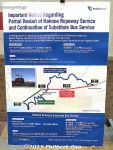
Explanation of Hakone ropeway's closure.
|
|
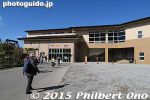
Ubako Station. On Oct. 30, 2015, they partially restarted the ropeway service on the last segment where it goes down from Ubako Station to Lake Ashi. Good views of the lake and Fuji-san.
|
|
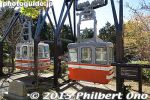
Old ropeway cars once used by the Hakone Ropeway.
|
|
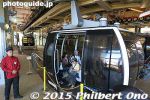
Ubako Station where we boarded the ropeway to go down the slope to Lake Ashi (Togendai).
|
|
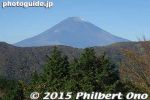
Mt. Fuji as seen from Ubako Station in Hakone. It was a clear autumn day in early Nov.
|
|
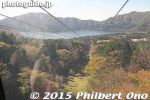
Lake Ashi is visible from our ropeway car.
|
|
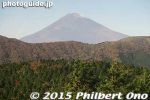
Mt. Fuji again.
|
|
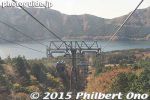
Getting closer to Togendai Station on the shore of Lake Ashi.
|
|
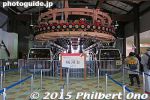
Togendai Station
|
|

Built in 1888, the former Hokkaido Government Office Building is one of Hokkaido's most famous buildings at the heart of Sapporo. With its red brick walls, it stands out among Sapporo's more modern buildings.
|
|

The building was akin to Hokkaido's capitol where the governor's office was located. It was used for 80 years. Open 9 am - 5 pm, closed Dec. 29-Jan. 3. Free admission. Near Sapporo Station's south exit and visible from Ekimae-dori road.
|
|

Nicknamed "Akarenga Chosha" (Red Brick Government Building), a fire in 1909 gutted the interior, but the exterior was little damaged. The building was restored in 1911. 赤れんが庁舎
|
|

Most of the building materials, stones and wood, were procured from Hokkaido. The building is flanked by yaezakura cherry trees which bloom in early May.
|
|

Tulips also give a colorful touch to the grounds. In 1968, the building was restored to its original state, and it has been preserved since then. It has an American Neo-baroque style.
|
|

In March 1969, it was designated as an Important Cultural Property. Its 2.5 million bricks were made locally and laid in a French style.
|
|
|
|

The roof has chimney-like ventilation outlets.
|
|
|
|

Former Hokkaido Government Office Building and tulips, Sapporo
|
|

Former Hokkaido Government Office Building and yaezakura cherry blossoms, Sapporo
|
|

Adjacent pond and cherry blossoms
|
|
|
|

G8 Summit countdown sign
|
|

The interior of the Former Hokkaido Government Office Building is just as dignified as the exterior. This triple-arch staircase is what you first see when you enter the building.
|
|

Rear of the triple-arch staircase.
|
|

Going to the 2nd floor.
|
|

Most of the rooms open to the public are on the 2nd floor.
|
|

Staircase and G8 Summit sign
|
|

Second floor corridor.
|
|

On the right is the entrance to the former Governor's office
|
|

The second floor has several large rooms. This is the Hokkaido Archives where Hokkaido's historical documents and records are kept.
|
|

Cannon balls
|
|

Inside the former office of the Governor. There's a large conference table and the walls are decorated with portraits of past Hokkaido governors.
|
|

Portraits of past Hokkaido governors. The bottom row are the most recent governors.
|
|

A stately room. The governor's desk is in the right corner.
|
|

Governor's desk in the governor's former office.
|
|

Another room on the 2nd floor shows Hokkaido's international relations with sister states in Alberta, Canada; Massachusetts, USA; and Heilongjiang, China.
|
|

From Alberta, Canada
|
|

From Massachusetts, USA. The famous Dr. William Clark was from this US state.
|
|

Photos of international sister state exchanges.
|
|

Red bricks
|
|

Karafuto/Sakhalin Resource Library
|
|

Hokkaido History Gallery occupies another room on the 2nd floor.
|
|

Hokkaido History Gallery includes wildlife exhibit.
|
|

There's also the Northern Territories Room with exhibits clamoring for the return of the northern territories (Shikotan, Habomai, Etorofu). now occupied by Russia.
|
|
|
|

Petition for the return of the Northern Territories. As of late April 2008, over 80.3 million people signed the petition.
|
|

Poster for the return of the Northern Territories
|
|

Poster for the return of the Northern Territories. Her braided hair resembles the northern islands.
|
|

First floor corridor. Most of the rooms on the 1st floor are closed to the public.
|
|

Point Zero for Hokkaido's travel distances.
|
|

Along the road to the former government building are display panels about Hokkaido's hisotry. Here's one about the early foreigners in Hokkaido.
|
|

Ryukyu Air Commuter DHC8-Q400CC (DH4) turboprop plane at Naha Airport.
|
|

Ryukyu Air Commuter DHC8-Q400CC (DH4) turboprop plane taking off from Naha Airport.
|
|

Ryukyu Air Commuter DHC8-Q400CC (DH4) propeller plane taking off from Naha Airport.
|
|

Usuzan Ropeway terminal on the left.
|
|

Usuzan Ropeway car holds over 100 people.
|
|

Leaving the ropeway terminal.
|
|

The ropeway distance is 1370 meters. It takes only 6 min. to reach Mt. Usu. The roundtrip ropeway fare is 1,450 yen for adults, 730 yen for kids.
|
|

Showa-Shinzan gets smaller.
|
|

Usuzan Ropeway, Lake Toya.
|
|

View of Lake Toya from the ropeway car.
|
|

View of Lake Toya from the ropeway car.
|
|

Lookout deck on Mt. Usu, near the ropeway terminal.
|
|

Toyako lookout deck on Mt. Usu, near the ropeway terminal. 洞爺湖展望台
|
|

Lake Toya lookout deck on Mt. Usu, near the ropeway terminal. Showa-Shinzan clearly in sight. 洞爺湖展望台
|
|

Lava dome on Mt. Usuzan
|
|

View of Showa-Shinzan and ropeway terminal.
|
|

Heading back to the ropeway terminal.
|
|

Ropeway terminal
|
|

Ropeway terminal
|
|

Going back down on the Usuzan Ropeway.
|
|

The Usuzan Ropeway terminal has gift shops selling a variety of G8 Hokkaido Toyako Summit merchandise. T-shirts, bags, candy, etc.
|
|

This box of cookies show all the G8 Summit leaders bathing in a hot spring and scrubbing each other's backs. They also say, "Ii yu!" (great hot spring) which is pronounced "EU" as a pun.
|
|
|

G8 Hokkaido Toyako Summit merchandise: Pins
|
|

G8 Hokkaido Toyako Summit merchandise: T-shirts
|
|

G8 Hokkaido Toyako Summit welcome sign at Usuzan Ropeway terminal.
|
|

G8 Hokkaido Toyako Summit welcome sign at Usuzan Ropeway terminal.
|
|
|
|
|
|